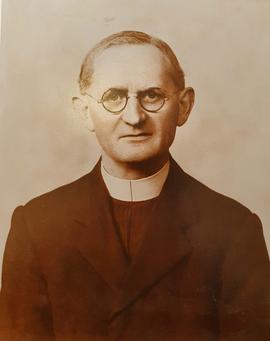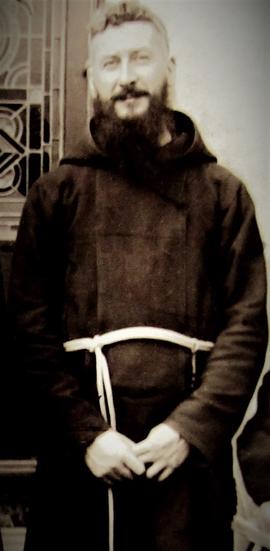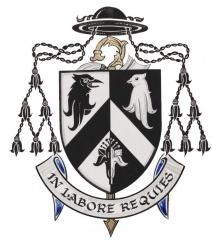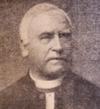Born: 17 March 1890 in Dromin, Killorglin, County Kerry
Reception: 23 December 1907, Mount St Joseph, Cork
Professed: 27 March 1910
Died: 13 June 1981
Interred: Blessed Edmund Rice Cemetery, Mount St Joseph, Cork
Thomas Griffin was born in the town of Doneraile in County Cork on 16 January 1886. He joined the Capuchin Franciscans in February 1903 and took Colman as his religious name. Having took his solemn vows in July 1908, he was ordained to the priesthood in May 1910. He subsequently pursued further theological studies at the International Capuchin College in Rome and received a Doctorate in Divinity (DD) from the Pontifical Gregorian University in the Italian capital. On his return to Ireland in 1914, he taught as a professor in theology in the Seraphic College in Rochestown, County Cork. He spent the greater part of his life teaching friars dogmatic theology both as a professor and as a director of students and master of novices. He held many senior leadership positions in the Order in Ireland and was several times guardian and vicar of various Capuchin communities. He was chosen as the first guardian (local superior) of the new Ard Mhuire foundation which was established in County Donegal in 1930. He was appointed superior of the newly established Raheny Hostel in Dublin in 1946. Fr. Colman was elected five times as a Provincial Definitor (Councillor) and served four terms as Provincial Minister (1937-40, 1940-3, 1949-51, 1952-5). He died in Raheny on 24 August 1971 and was buried in Glasnevin Cemetery in Dublin.
Baptismal name: Thomas Griffin
Religious name: Fr. Colman Griffin OFM Cap.
Date of birth: 16 Jan. 1886
Place of birth: Doneraile, County Cork (Diocese of Cloyne)
Name of father: Humphrey Griffin (Farmer)
Name of mother: Anne Griffin (née Carmody)
Date of reception into Capuchin Order: 19 Feb. 1903
Date of first profession: 19 Mar. 1904
Date of final profession: 31 July 1908
Date of ordination (as priest): 29 May 1910
Education attainments: BA (Royal University of Ireland, Cork, 1908); Doctorate in Divinity (Pontifical Gregorian University, Rome, 1914)
Leadership positions: Provincial Definitor (Councillor): 1925-8, 1928-31, 1931-4, 1934-7, 1946-9; Provincial Minister: 1937-40, 1940-3, 1949-51, 1952-5; Custos General: 1943-6, 1955-8.
Date of death: 24 Aug. 1971
Place of death: Raheny, Dublin
Place of burial: Glasnevin Cemetery, Dublin
Michael Griffin was born in Galway city on 6 October 1906. He joined the Irish Capuchins in Kilkenny in October 1925 and took Anselm as his religious name. Following his ordination to the priesthood in 1933, he served as spiritual director to philosophical students in St. Bonaventure’s University in Cork. On the outbreak of the Second World War, he volunteered for service as a military chaplain with the Royal Air Force in Britain. On his return to Ireland at the end of the conflict, he was assigned to the Capuchin community in Raheny in Dublin where his ministries included chaplaincy duties with the Christian Brothers’ Institute in Baldoyle. In 1950 he volunteered for overseas missionary work in Africa. Initially stationed in Northern Rhodesia (now Zambia), he later undertook parish work in Parrow in Cape Town, South Africa. Ill-health forced his return to Ireland, and he died in Cork on 14 February 1957. He was buried in the cemetery attached to Rochestown Capuchin Friary in County Cork.
Baptismal name: Michael Griffin
Religious name: Fr. Anselm Griffin OFM Cap.
Date of birth: 6 Oct. 1906
Place of birth: Nun’s Island, Galway city
Name of father: John Griffin (Prison Warder)
Name of mother: Honora (Nora) Griffin (née Kelly)
Date of reception into the Capuchin Order: 4 Oct. 1925
Date of first profession: 4 Oct. 1926
Date of final profession: 4 Oct. 1929
Date of ordination (as priest): 25 June 1933 (Letterkenny, County Donegal)
Educational attainments: BA (1929); Licentiate of Sacred Theology (STL), Rome (1935
Missionary activities: Travelled to Northern Rhodesian mission on 2 Feb. 1950.
Date of death: 14 Feb. 1957
Place of death: Bons Secours Hospital, Cork
Place of burial: Cemetery, Rochestown Capuchin Friary, County Cork
James Grealy was born in Dunnamaggin, County Kilkenny, on 6 October 1927. He was received into the Capuchin Order in October 1927 at St. Bonaventure’s in Cork. He took Hubert as his religious name upon joining the Order. He was ordained to the priesthood on 23 June 1935. He served as Director of Students at St. Bonaventure’s in Cork for twenty-one years (1944-67). Prior to this assignment, Fr. Hubert served as Vice-Master of Novices. In 1970 he was appointed Master of Novices, a position he would hold for five years (to September 1975). Throughout his life, he maintained a keen interest in Mariology and published several works on the subject. Later, his special interest in the Knock apparition led him to write several pamphlets, including ‘Towards an understanding of the Apparition at Knock’ (1959) and ‘The Meaning of St. Joseph’s Presence at the Apparition at Knock’ (1960). In 1975 the Franciscan Herald Press published his work on the souls in purgatory titled ‘The Mystery of Purgatory’. He was also involved in giving retreats (particularly to religious sisters). He spent the final years of his life in the Capuchin Friary in Raheny in Dublin. He died in a nursing home in Dalkey, County Dublin, and was buried in Glasnevin Cemetery.
Baptismal name: James Harold Grealy
Religious name: Fr. Hubert Grealy OFM Cap.
Date of birth: 6 Oct. 1907
Place of birth: Caherlesk, Dunnamaggin, County Kilkenny (Diocese of Ossory)
Name of father: Michael Grealy
Name of mother: Catherine Grealy (née Timon)
Date of reception into the Capuchin Order: 3 Oct. 1927 (Kilkenny Friary)
Date of first profession: 4 Oct. 1928
Date of final profession: 4 Oct. 1931 (St. Bonaventure’s Friary, Cork)
Date of ordination (as priest): 23 June 1935 (St. Eunan’s Cathedral, Letterkenny, County Donegal)
Leadership positions: Spiritual Director of Philosophy Students, St. Bonaventure’s Friary, Cork, 1944-67; Master of Novices, Kilkenny Friary, 1970-5
Date of death: 29 Mar. 1993
Place of death: Our Lady’s Manor Nursing Home, Dalkey, County Dublin
Place of burial: Glasnevin Cemetery, Dublin
William Grace was born in Dublin on 18 July 1936. He was received into the Capuchin Franciscan Order on 3 October 1953 and took John as his religious name. He spent his novitiate years in Rochestown Friary and obtained a Bachelor of Arts degree from University College Cork. He was ordained to the priesthood in County Donegal in June 1961. Following his ordination, he volunteered for missionary work and arrived in Livingstone in Northern Rhodesia (now Zambia) in September 1961. He remained a missionary friar in Zambia for the rest of his life (aside from year spent in St. Patrick’s College in Maynooth, County Kildare, taking a higher diploma in education). He returned to Zambia and took up a staff position at the Teachers’ Training College in Malengwa near Mongu in Western Zambia. He also acted as superior and parish priest in Malengwa, a location covering approximately two hundred and fifty square miles with a Catholic populace of about four thousand. He was appointed Vicar General in Mongu, the capital of the Western Province of Zambia, in 1997. He died in Lusaka, Zambia, on 2 October 2013. He was buried in the cemetery attached to the Capuchin novitiate at the Camerino Friary in Lusaka.
Baptismal name: William Grace
Religious name: Fr. John Grace OFM Cap.
Date of birth: 18 July 1936
Place of birth: Dublin
Name of father: John Grace
Name of mother: Catherine (Kathleen) Grace (née Hyland)
Date of reception into the Capuchin Order: 3 Oct. 1953
Date of first profession: 4 Oct. 1954
Date of solemn profession: 4 Oct. 1957
Date of ordination (as priest): 1 June 1961
Educational attainments: BA (1957); Higher Diploma in Education (1973)
Missionary activities: Travelled to Northern Rhodesia (later Zambia) on 26 Sept. 1961; Appointed Vicar General (Mongu, Zambia) on 14 June 1997.
Date of death: 2 Oct. 2013
Place of death: Lusaka, Zambia
Place of burial: Cemetery, Capuchin Novitiate, Camerino Friary, Lusaka, Zambia
Baptismal name: Michael Anthony Gough
Religious name: Fr. Jarlath Gough OFM Cap.
Date of birth: 22 Mar. 1904
Place of birth: Rush, County Dublin
Name of father: Thomas Gough (Carpenter)
Name of mother: Alicia Gough (née O’Donohoe)
Date of reception into the Capuchin Order: 18 Sept. 1921
Date of first profession: 15 Oct. 1922
Date of final profession: 29 Dec. 1925
Date of ordination (as priest): 29 June 1929
Educational attainments: BA (1925)
Missionary activities: Travelled to the United States in 1929; Pastor at Our Lady of Angels Parish, Hermiston, Oregon, 1930-3; returned to Ireland in 1936; Travelled to the Prefecture of Victoria Falls, Northern Rhodesia (later Zambia) in 1936; returned to Ireland in 1957; Parish Priest on the island of St. Helena from 1957-64 while attached to the Cape Town mission in South Africa.
Date of death: 30 Nov. 1983
Place of death: Little Sisters of the Poor Nursing Home, Sybil Hill, Raheny, Dublin
Place of burial: Glasnevin Cemetery, Dublin
John Glenny was born in Rathkeale in County Limerick on 20 November 1887. He joined the Capuchin Franciscans in September 1906 and took Ferdinand as his religious name. He was ordained to the priesthood on 5 July 1914. A year later he was transferred to the mission custody in United States. He ministered in the Sacred Heart Parish in Lincoln, Nebraska, and was instrumental in locating a new site for a church and adjoining hall. He returned to Ireland in November 1921. He spent time with Capuchin communities in Kilkenny and Dublin (he was transferred to Church Street in Dublin in 1944). He was mostly engaged in missions and retreats until ill-health forced his retirement from active ministry. He spent the last years of his life in Cork. He was a member of the Rochestown Capuchin fraternity in County Cork at the time of his death which occurred on 28 August 1963. He was buried in the cemetery adjoining Rochestown Friary.
Baptismal name: John Glenny
Religious name: Fr. Ferdinand Glenny OFM Cap.
Date of birth: 20 Nov. 1887
Place of birth: Boherbuoy, Rathkeale, County Limerick
Name of father: Patrick Glenny (Carpenter)
Name of mother: Mary Glenny (née O’Grady)
Date of reception into the Capuchin Order: 8 Sept. 1906
Date of first profession: 17 Sept. 1907
Date of final profession: 21 Jan. 1912
Date of ordination (as priest): 5 July 1914
Missionary activities: Travelled to the United States mission in Sept. 1915. He returned to Ireland in Nov. 1921
Date of death: 28 Aug. 1963
Place of death: Cork
Place of burial: Cemetery, Rochestown Capuchin Friary, County Cork
John Joseph Gleeson was born in Cork on 28 October 1910. He received his initial education with the Christian Brothers and later at the Capuchin College in Rochestown in County Cork. He joined the Order in November 1929 and took Richard as his religious name. After completing his novitiate, he graduated with a BA degree in philosophy and advanced to his theological studies. He was ordained to the priesthood at Ard Mhuire Capuchin Friary in County Donegal on 27 June 1937. Shortly afterwards, he was transferred to the American mission custody. He was initially assigned to St. Patrick’s Friary in Wilmington, Delaware, where he gave numerous missions, retreats, and novenas. He was also frequently chosen as the homilist at Requiem Masses for deceased friars. He worked as associate pastor, as vice novice master and teacher, and as guardian and pastor. Later in his life, he ministered in Capuchin foundations in California (Fort Bragg, Burlingame, and La Cañada Flintridge) and in Oregon (Roseburg and Bend). His health began to decline in the late 1950s and he was transferred to Our Lady of Angels Parish in Burlingame. He died on 18 June 1976 and was buried in the cemetery attached to San Lorenzo Seminary, Santa Inés, California.
Baptismal name: John Joseph Gleeson
Religious name: Fr. Richard Gleeson OFM Cap.
Date of birth: 28 Oct. 1910
Place of birth: 50 Evergreen Street, Cork
Name of father: Joseph Gleeson
Name of mother: Nora Gleeson (née O’Leary)
Date of reception into the Capuchin Order: 1 Nov. 1929
Date of first profession: 2 Nov. 1930
Date of final profession: 2 Nov. 1933
Educational attainments: BA, 2nd class hons. (1933)
Date of ordination (as priest): 27 June 1937 (Ard Mhuire Friary, County Donegal)
Missionary activities: Travelled to the United States mission in 1937
Date of death: 18 June 1976
Place of death: Burlingame, California
Place of burial: Cemetery, San Lorenzo Seminary, Santa Inés, California









